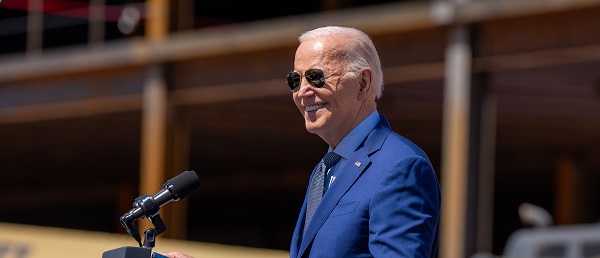Daily Caller
Trump Confirms He Will Declare National Emergency, Use Military Assets For Mass Deportation

 From the Daily Caller News Foundation
From the Daily Caller News Foundation
President-elect Donald Trump confirmed Monday that he will declare a national emergency and use military assets to help him carry out his mass deportation plans.
“True!!!” the president-elect posted on Truth Social early Monday morning in response to a post by Tom Fitton, the president of Judicial Watch. Fitton had posted about reports indicating the incoming Trump administration was “prepared to declare a national emergency and will use military assets to reverse the Biden invasion through a mass deportation program.”
The post on Truth Social was the latest indication that the president-elect and his administration intend to carry out an incredibly hardline immigration enforcement agenda for the next four years.
During the campaign, Trump pledged to continue building the U.S.-Mexico border wall, revive the Remain in Mexico program, hire more border patrol agents and conduct the “largest deportation program in American history.” He has also declared he will end birthright citizenship for those born on U.S. soil to illegal migrant parents.
The incoming administration appears poised to follow through on this hardline agenda given the individuals tapped to lead top immigration enforcement roles. The White House transition team has picked former Immigration and Customs Enforcement (ICE) acting director Tom Homan to serve as border czar, Stephen Miller to serve as deputy chief of staff for policy and South Dakota Gov. Kristi Noem to lead the Department of Homeland Security — all of whom are considered very hawkish on border enforcement.
Trump has yet to name who will lead ICE, Customs and Border Protection, or U.S. Citizenship and Immigration Services, which are three agencies within DHS that play a critical role in the American immigration process
This would not be the first time Trump has used his national emergency authority to help his immigration agenda.
During his first term, the Republican president declared a national emergency in order to secure more funding for wall construction along the U.S.-Mexico border. He later extended this national emergency declaration in order to maintain progress for wall construction efforts.
As in his first term, Trump is likely to face lawsuits against his immigration agenda from immigrant rights groups and other liberal organizations. The American Civil Liberties Union (ACLU) has filed more than 400 legal actions against Trump and his first administration since 2016, with a large portion targeting immigration directives, and has vowed to go to court again once Trump resumes office.
“Starting on day one, we’re ready to fight for our civil liberties and civil rights in the courts, in Congress, and in our communities,” the organization stated after Trump’s Election Day victory. “We did it during his first term — filing 434 legal actions against Trump while he was in office — and we’ll do it again.”
Daily Caller
Biden Administration Was Secretly More Involved In Ukraine Than It Let On, Investigation Reveals


From the Daily Caller News Foundation
By Wallace White
The U.S was far more directly involved in aiding Ukrainian forces against Russia than previously understood, a New York Times investigation revealed Monday.
American backing of Ukraine was an instrumental piece in forces of the eastern European nation wounding or killing more than 700,000 Russian soldiers during the course of the war, according to the NYT. Methods the U.S. used to aid Ukraine included giving target information while officially obfuscating their nature, dispatching American advisers close to the frontlines and sweeping oversight over its use of missile systems granted by officials.
One European intelligence official was taken aback as to how deep U.S. involvement was, telling the NYT that American officials had become “part of the kill chain.”
Dear Readers:
As a nonprofit, we are dependent on the generosity of our readers.
Please consider making a small donation of any amount here. Thank you!
Ukrainian officials met in Wiesbaden in Spring 2022, the headquarters of the U.S. European Command, to discuss strategy with U.S. forces and the extent to which the U.S. would aid the Ukrainians.
During the meeting, U.S. European Command settled with Ukrainian officials that they would reportedly dispense target locations as “points of interest” to the Ukrainians, not officially calling them “targets” as they believed the language would be too “provocative.”
“If you ever get asked the question, ‘Did you pass a target to the Ukrainians?’ you can legitimately not be lying when you say, ‘No, I did not,’” a U.S. official told the NYT. Most artillery strikes were carried out with the M777 Howitzer system, in part provided by the U.S.
Due to diplomatic risks, the Biden administration wanted to share intel in the most plausibly deniable way possible, with a total restriction on sharing the whereabouts of Russian military figures and targets on Russian soil, one senior U.S. official told the NYT. The information shared would have to adhere to NATO guidelines of intel sharing to not provoke the Russian’s ire against other nations in the alliance.
“Imagine how that would be for us if we knew that the Russians helped some other country assassinate our chairman,” the official told the NYT. “Like, we’d go to war.”
European Command also had sweeping oversight of the Ukrainian use of the HIMARS missile system, the Americans retaining the ability to shut off the activation key cards required to fire the missiles, according to the NYT. HIMARS strikes regularly resulted in hundreds of Russian deaths weekly.
Advisers regularly made visits to the frontlines of the war, referred to as “subject matter experts” in their official capacity, according to the NYT. Their official names only changed back to “advisers” once Ukrainian leadership changed, which was also followed by a threefold increase in advisers.
Despite the deep cooperation, there was often tension between the U.S. and Ukraine, with Kiev often accusing the Americans of being overbearing, while the Americans questioned why sometimes Ukrainians did not heed their advice, according to the NYT.
Business
Biden’s Greenhouse Gas ‘Greendoggle’ Slush Fund Is Unraveling


From the Daily Caller News Foundation
By Michael Chamberlain
We warned you: this gas didn’t smell right from the beginning.
The Greendoggle has made the big time! Not every shady government giveaway to special interests gets its own Wall Street Journal editorial.
But how often does the new EPA administrator announce that his staff has discovered that $20 billion that had been appropriated for the Greenhouse Gas Reduction Fund (GGRF or “Greendoggle”) had been “parked” in a bank by the Biden EPA until it could be ladled out as grants to climate industry cronies? That’s what Administrator Lee Zeldin announced back in February, referencing a Biden appointee who was infamously caught on tape explaining that the agency was “throwing gold bars off the Titanic” – trying to get the unspent money out of the reach of the Trump administration. Zeldin’s “clawing back” that money, and the lawsuit by “public-private investment fund” Climate United to get the $7 billion it was awarded, has got the media paying attention. Finally.
Administrator Zeldin’s announcement that EPA is taking back the $2 billion awarded to an organization tied to prominent political figures marks another auspicious turn in the GGRF saga, which Protect the Public’s Trust (PPT) has followed and warned about since the beginning. Passed as part of the Inflation Reduction Act (Mr. Orwell, please call your office …), the GGRF was a massive spending program that would provide funds to environmentalist groups to finance green technology projects. The sheer amount of money Congress shoveled at the EPA was unprecedented. Unfortunately, it didn’t come with commensurate oversight resources – Mr. Zeldin says this was by design. The result was the Greendoggle, an environmentalist slush fund administered by insiders for insiders.
According to emails PPT obtained via FOIA request, the EPA invited a group of green activist organizations and thinktanks to a highly irregular November 2022 meeting to “provide early feedback on the RFI and ask clarifying questions.” And, as PPT foresaw, several groups with ties to EPA officials are on the invitation list. EPA’s “revolving door” with radical environmental groups spun fast in the Biden years.
PPT dug in and researched the green banks, finding multiple insider connections to the Biden administration. “With $27 billion dollars sloshing around, the American public should be on high alert for waste, fraud and abuse,” we warned in October 2023.
The next month, when the “short list” of coalitions vying to become GGRF distributors was announced, the Daily Caller News Foundation’s Nick Pope, whose reporting on the GGRF since early on has been essential in exposing the Greendoggle, revealed it featured “several organizations with considerable connections to the Biden administration, as well as the Democratic Party and its allies.” To put it mildly.
As the Greendoggle came together, the legacy media remained incurious, but for anyone paying attention, it smelled bad. There seemed to be no accountability, and given the Biden EPA’s ethical track record, that was concerning, to say the least.
One of the eight entities eventually chosen was the Coalition for Green Capital (CGC), a green bank whose mission is to “accelerate the deployment of clean energy technology throughout the US while maintaining a targeted focus on underserved markets.” CGC board member David Hayes left the organization for nearly two years to join the Biden White House Climate Policy Office as a special assistant to the president. He then went back to the CGC board. As PPT put it in a complaint it filed in June 2024 with the U.S. Office of Government Ethics and the EPA’s inspector general (and which the Zeldin EPA cited in its legal defense of the clawback), while at the White House Hayes “presumably worked at the highest level on the very GGRF program from which CGC sought funding upon his return. This timing is suspect considering CGC itself publicly announced his return to its board as part of its effort to obtain GGRF funding.” Not very subtle, but it worked. CGC got a $5 billion windfall out of the Greendoggle.
It just so happened that, while Mr. Hayes was in the administration, so was another CGC veteran, Jahi Wise. Like Hayes, Wise was a special climate assistant to the president, until he joined the EPA in December 2022 as … founding director of GGRF. Subtlety doesn’t seem to be among the skill sets CGC looks for in its people. Wise at least didn’t return to CGC after that. He joined a George Soros foundation.
The GGRF should become a metaphor for congressional shortsightedness, bureaucratic arrogance and the venality of special interests at the government trough. The “green” industry is an industry like any other, green special interests are special interests and the color of a taxpayer dollar doesn’t change because it’s being wasted in a nominally noble cause.
The Greendoggle stank, gas and all.
Michael Chamberlain is Director of Protect the Public’s Trust.
-

 2025 Federal Election2 days ago
2025 Federal Election2 days agoJoe Tay Says He Contacted RCMP for Protection, Demands Carney Fire MP Over “Bounty” Remark
-

 2025 Federal Election2 days ago
2025 Federal Election2 days agoHong Kong-Canadian Groups Demand PM Carney Drop Liberal Candidate Over “Bounty” Remark Supporting CCP Repression
-

 2025 Federal Election2 days ago
2025 Federal Election2 days agoPoilievre To Create ‘Canada First’ National Energy Corridor
-

 2025 Federal Election2 days ago
2025 Federal Election2 days agoAlcohol tax and MP pay hike tomorrow (April 1)
-

 2025 Federal Election2 days ago
2025 Federal Election2 days agoChinese Election Interference – NDP reaction to bounty on Conservative candidate
-

 2025 Federal Election2 days ago
2025 Federal Election2 days agoChina Election Interference – Parties Received Security Briefing Days Ago as SITE Monitors Threats to Conservative Candidate Joe Tay
-

 2025 Federal Election2 days ago
2025 Federal Election2 days agoFixing Canada’s immigration system should be next government’s top priority
-

 2025 Federal Election1 day ago
2025 Federal Election1 day agoPoilievre, Conservatives receive election endorsement from large Canadian trade union





